A national monument: The Field of Freedom’s Birth
 As our local council considers whether or not there should be a new national monument to Magna Carta at Runnymede, and what form that could take, it is worth reflecting for a moment on the existing national monument overlooking the meadow: the Air Forces Memorial.
As our local council considers whether or not there should be a new national monument to Magna Carta at Runnymede, and what form that could take, it is worth reflecting for a moment on the existing national monument overlooking the meadow: the Air Forces Memorial.
Designed by Sir Edward Maufe, architect for the Imperial War Graves Commission, and with sculpture by Vernon Hill, the Air Forces Memorial at Runnymede is arguably the most poignant and impressive feature in this modern monumental landscape.
The symbolism captured in Portland Stone is striking, from its tower, reminiscent of an airfield control tower, to the three Hill figures above the central arched opening representing Justice, Victory and Courage. As the 1951 Egham Town Guide said of the then planned memorial: “The design arises out of its own special conditions, for the recording of the names of the airmen is special in that they were banded together in small units. A Cloister is a traditional and well-loved architectural form and, being necessarily made up of many small units, very happily and naturally fulfils this need.” As the Guide continues: “The site is a splendid one, high up over Runnymede, with a wide view over seven counties to Windsor Castle in the west and Heath Row [sic] in the east.”
It is the choice of Runnymede as the site for the memorial that is arguably most significant. As Queen Elizabeth II said in her address at the unveiling of the memorial on the 17th October 1953:
It is very fitting that those who rest in nameless graves should be remembered in this place. For it was in those fields of Runnymede seven centuries ago that our forefathers first planted a seed of liberty which helped to spread across the earth the conviction that man should be free and not enslaved. And when the life of this belief was threatened by the iron hand of tyranny, their successors came forward without hesitation to fight and, if it was demanded of them, to die for its salvation. As only free men can, they knew the value of that for which they fought, and that the price was worth paying.
Perhaps the most moving feature of the memorial though is Paul H. Scott’s poem, engraved on a north facing window in the first floor gallery overlooking Runnymede, or the ‘field of freedom’ as it described.
The first rays of the dawning sun
Shall touch its pillars,
And as the day advances
And the light grows stronger,
You shall read the names
Engraved on the stone of those who sailed on the angry sky
And saw harbour no more.
No gravestone in yew-dark churchyard
Shall mark their resting place;
Their bones lie in the forgotten corners of earth and sea.
But, that we may not lose their memory
With fading years, their monuments stand here,
Here, where the trees troop down to Runnymede .
Meadow of Magna Carta, field of freedom,
Never saw you so fitting a memorial,
Proof that the principals established here
Are still dear to the hearts of men.
Here now they stand, contrasted and alike,
The field of freedom’s birth, and the memorial
To freedom’s winning.
While we can argue as to whether Magna Carta itself truly is the fount of modern liberty, few would argue that there is something to the association of this meadow with freedom. It is a landscape of liberty not simply because it witnessed the sealing of a peace treaty between rebellious Barons and the King in the thirteenth century but because, through centuries of conscious and semi-conscious association, memorialised in stone and commemorated in pageants and processions, we, the people, have made it so.
Note: Image from Egham Town Guide 1951. © The Egham Museum Trust
